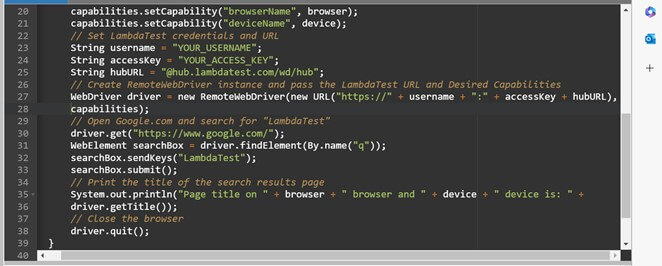
Selenium for API Testing: Tips and Tricks
Are you a fan of the Terminator movies? Well, who isn’t, right? There’s nothing quite like watching Arnold Schwarzenegger in action, taking on the world, one villain at a time. But have you ever considered how much simpler his job would become if he had a Selenium-based robot as a companion? Imagine all the automation testing tasks that could be taken care of, leaving more time for him to focus on saving the world!
While we may not have a robot that can automate all our API testing tasks (yet!), we do have Selenium, an open-source tool popularly used for the automation testing of browsers and web applications. But did you know that you could also use Selenium for API testing? Yes, you heard it right! In this article, we’ll be discussing some tips and tricks for using Selenium for API testing.
So if you’re ready to take your API testing skills to the next level, grab some popcorn and get ready to dive into the world of Selenium and API testing. After all, who knows? Maybe one day, with the help of Selenium and automation testing, we’ll be able to save the world, just like Terminator!
Tips and Tricks For Using Selenium For API Testing
First and foremost, it’s important to understand that Selenium is primarily designed for UI testing, but with the help of some additional libraries, it can also be used for API testing. One such library is Rest-Assured, which provides a simplified way to test RESTful APIs. So, if you’re a fan of APIs and Selenium, this is a match made in heaven.
Now, let’s talk about some tips and tricks for using Selenium for API testing.
1. Understand the basics of API testing
Before you start using Selenium for API testing, it’s essential to understand the basics of API testing. API testing is an essential step in the software development process as it ensures that the software interfaces are working as intended. These interfaces enable different applications to communicate with each other, and if they fail to function correctly, it can cause a range of issues, including data loss, system downtime, and performance issues.
API testing helps to identify any issues or defects in the software interfaces before they can cause any significant problems. It also helps to ensure that the APIs are delivering accurate, consistent, and timely results, which is crucial for the proper functioning of any software application.
2. Use WebDriver to Make API Requests
Selenium WebDriver is designed to interact with web pages, but it can also be used to send HTTP requests to APIs. This is especially useful when testing APIs that require authentication. Just like Batman has a utility belt with gadgets to help him fight crime, WebDriver can be your trusty tool for API testing.
3. Use Assertions to Validate API Responses
When testing APIs, it’s important to verify that the response is what you expect. Assertions provide a way to check whether the response matches your expectations. It’s like using X-ray vision to see through the smoke and mirrors of a villain’s disguise. By using assertions, you can catch bugs early in the development process and ensure that your API is functioning as intended.
4. Use Data-Driven Testing to Increase Test Coverage
Data-driven testing involves running the same test with multiple sets of data. This can help you test different scenarios and edge cases, and increase the overall test coverage of your API. Just like Doctor Strange can see all possible outcomes of a situation, data-driven testing can help you prepare for any scenario.
5. Use Parameterization to Test Multiple Inputs
Parameterization is the process of testing multiple inputs to a single API. By changing the input values, you can test the different scenarios the API might encounter.. By using parameterization, you can ensure that your API is robust enough to handle different inputs and use cases.
6. Use Logging and Reporting to Track Results
Logging and reporting can help you track the results of your API tests. By using logging, you can capture information about the test process and any errors that occurred. Reporting allows you to share the results with your team and stakeholders.
7. Use Mocking to Simulate Dependencies
Mocking is the process of creating a fake version of a dependency that an API relies on. By doing this, you can test the API without having to access the real dependency. This can be useful if the real dependency is not available or if you want to test the API in isolation.
8. Use Parameterized and Reusable Test Scripts
Creating parameterized and reusable test scripts can save time and effort in the long run. Parameterized scripts allow you to test multiple inputs with a single script, while reusable scripts can be used for different APIs or endpoints. By creating parameterized and reusable test scripts, you can increase efficiency and reduce the time and effort required for testing.
9. Use the RESTful API
RESTful APIs are mostly used in web applications. They use HTTP methods like GET, POST, PUT, and DELETE to perform CRUD (Create, Read, Update, Delete) operations on resources. Selenium can be used to test RESTful APIs by sending HTTP requests and receiving responses.
10. Use the HTTP request methods
To test an API with Selenium, you can use the HTTP request methods like GET, POST, PUT, and DELETE. To do this in Python, you can use the requests module to send HTTP requests and receive responses.
Let’s say you’re planning a surprise party for your best friend, and you need to order a cake. You’ll need to send a request to the bakery to order the cake, and they’ll respond with a confirmation and the delivery time. This is similar to how APIs work, where you send a request, and the API responds with the requested data.
Below is an example of how you can use the GET method to retrieve information from an API:

In this example, we’re using the GET method to retrieve information about a post from a public API. The URL ‘https://jsonplaceholder.typicode.com/posts/1’ specifies the endpoint we want to access, and the response variable stores the response from the API. We then print the status code and the response data in JSON format.
Similarly, you can use other HTTP methods like POST, PUT, and DELETE to interact with APIs. Here is an example of how the ‘POST’ method can be used to send information to an API:

In this example, we’re using the POST method to send data to the API endpoint ‘https://jsonplaceholder.typicode.com/posts’. The data variable stores the data we want to send, and the response variable stores the response from the API. We then print the status code and the response data in JSON format.
Just like ordering a cake, you can send requests to an API and receive the desired data, making it easier to test and validate the API’s functionality.
11. Use exception handling
With any testing process, there are bound to be exceptions and challenges along the way. That’s why it’s crucial to know how to handle exceptions. Exception handling is used to handle errors that occur during API testing. You can use try-except blocks in Selenium to handle exceptions and log errors.
12. Practice good coding practices
Finally, it’s essential to practice good coding practices when using Selenium for API testing. This includes writing clean and readable code, using comments to explain the code, and following the DRY (Don’t Repeat Yourself) principle.
While Selenium may not be the first tool that comes to mind for API testing, it can be a powerful asset in your automation testing toolkit when used in conjunction with Rest-Assured and other libraries. With the right tips and tricks at your disposal, you can streamline your testing process and have more time for the things you enjoy. So why not give Selenium a try and see how it can make your API testing process more efficient and effective?
Transform Your Selenium Automation For API Testing with LambdaTest – The Ultimate Testing Companion!
LambdaTest is an online platform where you can easily run automated tests on a range of browsers and devices, saving you time and effort. This platform provides you with access to 3000+ real browsers, OS, and devices, including the latest versions of Chrome, Firefox, Safari, Edge, and more.
LambdaTest, also leverages the latest technology to take your testing to the next level. Our integrations with popular tools like Jira, Slack, and GitHub allow you to easily manage your testing process and collaborate with your team, no matter where you are in the world. And our parallel testing capabilities allow you to run tests simultaneously, reducing your testing time significantly.
Let’s have a look at the code snippet of running a Selenium test on LambdaTest platform to make Selenium testing hassle free.
Here’s an advanced example of Selenium code that can be run on LambdaTest platform to perform cross-browser and cross-device testing:


This code performs cross-browser and cross-device testing on multiple combinations of browsers and devices using LambdaTest platform. It uses a nested loop to iterate through the list of browsers and devices, and sets the Desired Capabilities for each combination. It then opens Google.com, performs a search for “LambdaTest”, and prints the title of the search results page for each combination of browser and device. Finally, it closes the browser after each iteration.
Make sure to replace “YOUR_USERNAME” and “YOUR_ACCESS_KEY” with your own LambdaTest username and access key respectively. You can also customize the list of browsers and devices based on your testing requirements.
Now, you have done Selenium Automation, you must be concerned about keeping a record of analytics and results and also sharing them. Don’t worry LambdaTest Automation API is at your rescue?
LambdaTest Automation API
It helps you manage your test builds, test sessions, and tunnel status and it does this by providing you with a JSON format file of platforms this file contains the syntax of all the browsers according to a particular OS.
All test data belonging to an account can be fetched and managed that includes fetching the build details, screenshots of test sessions, command logs, network logs, Selenium logs, etc.You must append all your end-points that you might want to invoke for automated cross-browser testing on the Selenium Grid of LambdaTest, on the below-enumerated URL to leverage LambdaTest API.
https://api.lambdatest.com/automation/api/v1/
Few Examples Of the Builds and Sessions end-points
1. Triggering a GEThe below end-point, you can fetch the build of an account
/builds
2. To delete a build, you can use DELETE request on the below end-point
/builds/{build_id}
3. Trigger a GET request on the below end-point to get a list of all test sessions
/sessions
4. Triggera GET request on the below end-point to fetch all screenshots of a test session.
sessions/{session_id}/screenshots
Wrap-up
Using Selenium for API testing can help you catch bugs like a superhero. By using WebDriver to make API requests, assertions to validate responses, and data-driven testing to increase test coverage, you can ensure that your API is functioning as intended. And who knows, maybe one day we will see a movie about an API testing hero who saves the world. But until then, you can be the hero of your own development team by using these tips and tricks.

![BEST FREE GPU Benchmark Software For PC [TESTED] 2024](https://clooudi.com/wp-content/uploads/2024/10/best-free-gpu-benchmark-software-for-pc-tested-2024--390x220.jpg)

